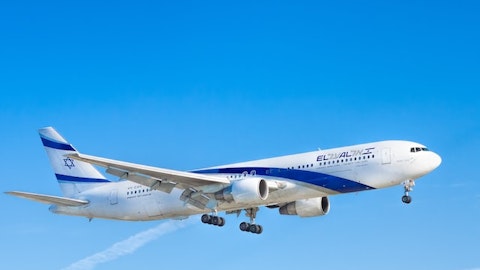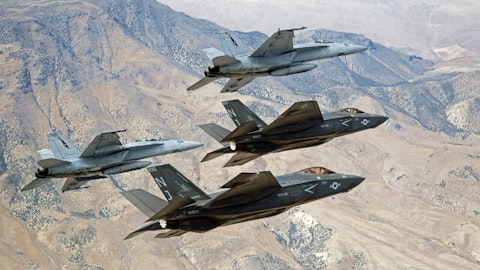Antonio Carlos Garcia: Good morning, Myles. Thanks for your question. In regards to CapEx for Executive Aviation, we are since 1.5 years doing some adaptation in our production capacity in order to be more efficient and also to support the growth. And we are continuing to grow with the book to be 1.3:1, what we did already in 2023. Therefore, it’s just painting both completion and safety in order to be leaner and avoid too many travel work for the executive and also to adjust for the capacity. On the MRO side or in the services side is more expansion in our MRO. I would say, organic growth that we are fostering right now. And on top of it, for our new products is not there yet any type of decision. Decision to be made if 2025, maybe Francisco could comment on the last one.
Francisco Gomes Neto: Thank you very much, Antonio. Just to complement Antonio’s answer, in terms of new products, we are investing on innovation. We are investing on seven innovation verticals in order to close the technology gaps to be ready to go for a new program in the next future. We also made you know as we do all the time in marketing studies and product studies you know in order to be prepared for next steps for Embraer. For now, we have a very young and competitive portfolio of products developed in the less than 10 years and we are in a good moment. We want to sell those products and improve our financial performance. So that’s what we’re doing. But again, we are investing, we have a good investment in new technologies and innovation verticals.
Myles Walton: Thank you. I’ll stick to one.
Francisco Gomes Neto: Thank you.
Operator: The next question is coming from a telephone number with the end of 1339. We ask for you to introduce yourself before asking the question. Please go ahead.
Cai Von Rumohr: Yes, thanks so much, Cai Von Rumohr. So in your guide, what is the relative mix within commercial between E1s and E2s and deliveries for ’24 and also in biz jets between lights and mediums. And also, if you think about most biz jets makers make more money on the larger jet and it looks like yours is reversed. Is there any opportunity for the profitability of the medium bizjets to improve? Thank you.
Antonio Carlos Garcia: Hello, Cai, Antonio speaking. Thanks for your question. It’s always very nice. For the commercial jets for 2024, we are targeting 60% in E2 and 40% in E1 and the mix, okay? And for the Executive Aviation, it’s more or less light jets around 55 and 45 to midsize jets. I would say, we are seeing a margin expansion for Executive Aviation, but percentage wise, our margin is much better than light jets, the midsized jets. However, where we are going much more is in the midsized jets, that’s why I would say we should be able to get some margin improvement, but not as the same we have in the light jet, for the midsized jet, we do have more competition, that’s why, I would say, in order to keep our guidance to the market, we are being a little bit conservative. I would say, same margin, but with much more dollars to come with the expansion production for the midsized jets. Thank you.
Cai Von Rumohr: Thank you very much.
Operator: The next question comes from Jordan Leone with Bank of America. Please go ahead. Excuse me, sir. We cannot hear you. If you could please unmute your phone.
Jordan Lyonnais: So sorry about that. Can you hear me now?
Operator: Yes. Thank you.
Jordan Lyonnais: Okay. Thank you. Sorry. Could you talk a little bit more about the read-through on the United and the American orders to the 175. Should we look at this as a new replacement opportunity for RJs?
Francisco Gomes Neto: Yes, sure. So I mean, this new order shows to us that the — that market of regional jets in the US is recovering. I mean although the pilot shortage situation is not resolved, the market is recovering, and this was the first important movements. And this will be very important for us to make a — to have a health mix of aircraft between E1s and E2s in the following years. So as E1s continue to be the workforce in the regional aviation in the US.
Antonio Carlos Garcia: Francesco, just to complement the united issue, it was just a repositioning 20 units to Mesa, which just does not mean a new backlog. But for sure, we do have interest from the other players in positions for the E1. Even that our big competitors who are saying that the regional market is dead, but as you can see, it’s not as dead as more in live that we all believe and the order they are just confirming what we were saying in the last years.
Jordan Lyonnais: Great, thank you.
Operator: The next question comes from Jay Singh with Citi. Please go ahead.
Jay Singh: Hey, thanks for taking my question. It’s Jay from Stephen Trent’s team. My first question is do you guys have any updates on the E2 sales campaign in and out of the US?
Francisco Gomes Neto: Well, we cannot disclosure about sales campaigns. But what I can tell you is that, yes, we are working. We are in conversations with potential customers of E2s in the US.
Jay Singh: All right. Awesome. Thanks. And my second question is regarding EVE, what are your thoughts on the certification process, really considering that the FAA is probably under a little bit of pressure right now regarding recent commercial airlines incidents? Just any color on that would be great. Thanks.
Antonio Carlos Garcia: You asked about the EVE certification. Is that right?
Jay Singh: That’s right. Okay.
Antonio Carlos Garcia: Okay. We are having an important progress on EVE development. I mean the key suppliers are already did finance for the product. We are progressing well in the assembling of the first prototype, the PAF 2, scale 1:1 that we expect to fly end of this year, beginning of next year. So we are committed for the entry into service of the — our eVTOLs to the end of 2026.





